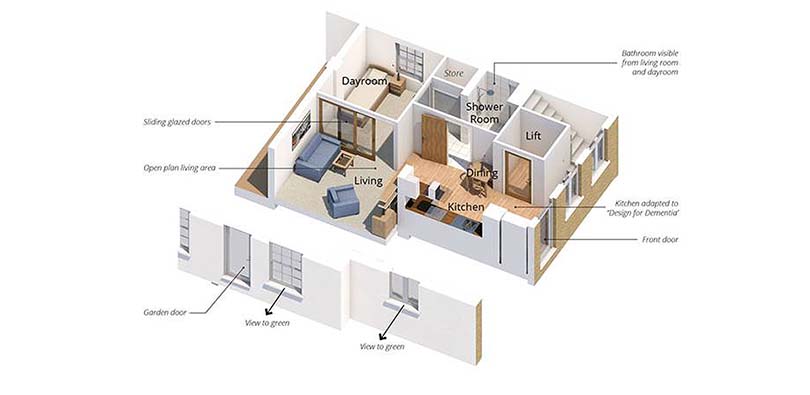
A show home designed around concepts and technologies which will allow people with dementia to live independently for longer has been officially opened.
The house, at the BRE Innovation Park in Watford, features a vast collection of intuitive ideas, all based on proven academic research, from simple open-plan living spaces to more hi-tech innovations such as ‘talking cushions’, which promote activity after long periods of rest, sensory ‘smart chairs’, self-regulating climate control and safety sensors in high risk areas, such as the kitchen.All of the features in the home were designed around a range of unique personas, created especially for the project, which reflect four progressive stages of dementia, from early on-set to end-of-life.
The converted 100sqm Victorian semi has been unveiled to 150 invited guests, all with an interest in dementia or health care, and television, radio and print journalists.
Lord Richard Best, Chair of the All Party Parliamentary Group on Housing and Care for Older People, was the guest of honour and gave a short talk before the ribbon was cut, on Wednesday, July 4.
The innovations and ideas have been devised by experts at Loughborough University, BRE and HLP Architects.
The house is open to the public, care-providers, local authorities, architects and anyone with an interest in dementia care to allow them to gather ideas, solutions and inspiration from the technology and design on show.
Examples of features include:
- Clear lines of sight and use of colour through the home help guide people towards specific rooms and reduce the risk for slips and trips
- Increased natural lighting, which has been shown to help people stay alert during the day and to sleep better at night
- Noise reduction features, to reduce stress and agitation
- A ‘talking cushion’ with inbuilt sensors to remind people to get up, walk around and get a drink because walking is beneficial for health and dehydration can cause cognitive problems
- Homely, simple and familiar interior design to help promote rest and relaxation
- Space to install a lift so the lounge does not become a bedroom when the stairs become difficult
One of the home’s more hi-tech features is an Acti-chair, which includes resistance bands with inbuilt sensors to guide strength, speed and direction of movement.
The chair was co-designed by Delft University of Technology and Loughborough’s Living Laboratory in partnership with people with dementia – using a simple system with emoji for feedback.
The Acti-chair not only promotes physical wellbeing but also improves memory by encouraging repetition of exercise patterns.
“Strength exercises can improve memory, even with three 30 minute sessions a week,” said the NCSEM-EM’s Professor Eef Hogervorst, an expert in early dementia diagnoses and lifetime risk and protection.
“Many older people are sedentary and people with dementia often spend most of their time at home, which can enhance memory problems.
“Loughborough’s research by Jordan Elliott King and others shows that exercise promotes memory function and independence, also in people with dementia – so any features which encourage the uptake of activities, including the ‘talking cushions’, are key in the design of the house.”
Professor Hogervorst said that technology like the personas, ‘talking cushion’ and Acti-chair combined with the latest understanding of the condition is what makes the house an important step forward in dementia care.
“There are lots of small, simple changes people can make to their homes which will help with better independent living.
“The beauty of this project is that we’ve been able to create and adapt new technologies to support the knowledge we already have.”